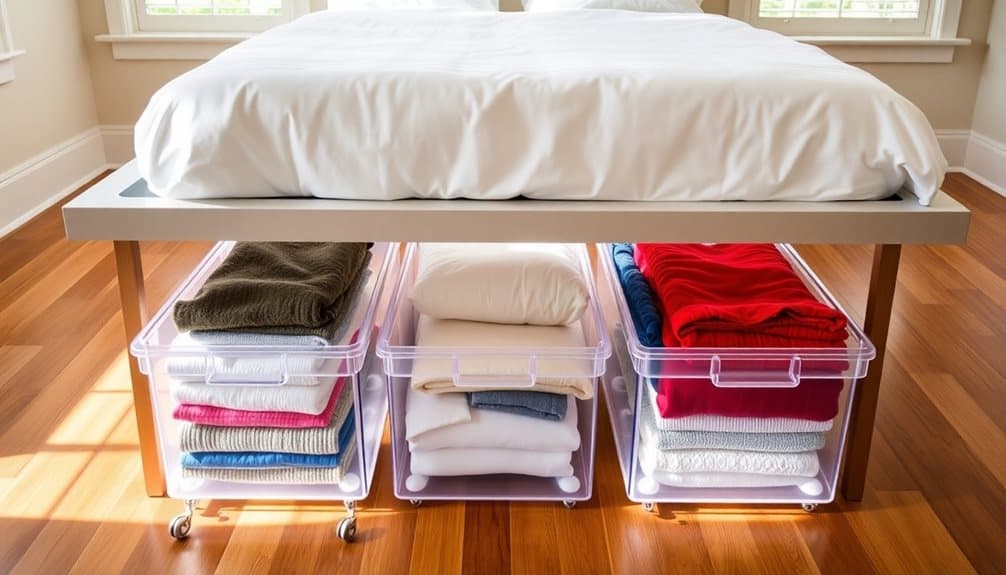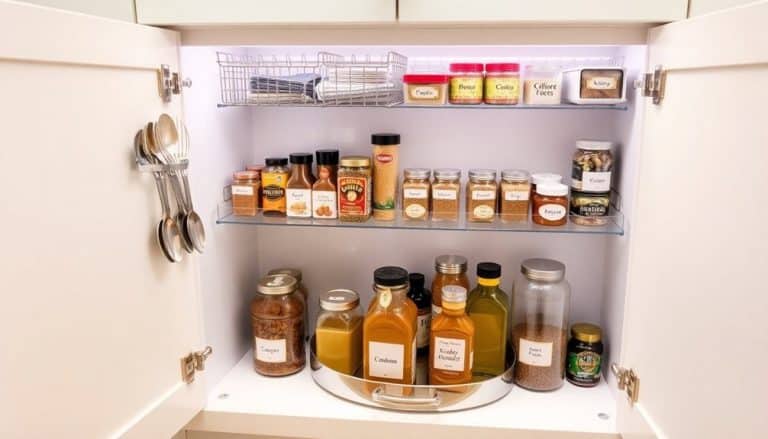This website contains affiliate links. Some products are gifted by the brand to test. As an Amazon Associate, I earn from qualifying purchases. The content on this website was created with the help of AI.
Transform your cluttered bedroom into an organized oasis with three proven storage solutions. Start by maximizing under-bed space using low-profile containers with wheels and vacuum-sealed bags for seasonal items, instantly doubling your storage capacity. Next, take advantage of vertical wall space by installing floating shelves and pegboards, creating customizable storage that adapts to your needs. Finally, utilize your door’s untapped potential with over-the-door organizers featuring clear pockets for shoes, accessories, and everyday essentials. These smart strategies will help you discover hidden storage possibilities throughout your bedroom space.
Key Takeaways
- Install bed risers to instantly create additional under-bed storage space for seasonal clothing and bulky items in wheeled containers.
- Use clear over-door shoe organizers for storing not just shoes, but also accessories, toiletries, and small clothing items.
- Mount floating shelves at varying heights to maximize vertical wall space and create instant storage for books and decorative items.
- Implement vacuum-sealed storage bags to compress winter clothing and bedding, reducing storage volume by up to 75%.
- Create organized zones under the bed using drawer dividers and clear containers for easy access to frequently used items.
Under-Bed Storage Solutions

The untapped space beneath your bed offers prime real estate for storage optimization. To maximize this space, invest in low-profile storage containers with wheels for easy access. Choose clear bins to quickly identify contents, or opt for vacuum-sealed bags to compress bulky items like winter clothing and extra bedding.
If you’re working with a standard bed frame, add bed risers to create additional height – each inch gained provides valuable cubic feet of storage space. For a more polished look, consider a platform bed with built-in drawers or a hydraulic lift-up storage system that raises the entire mattress.
Don’t let the space go unorganized. Divide your under-bed area into zones using drawer dividers or smaller containers. Keep seasonal clothing toward the back, and frequently accessed items near the foot of the bed where they’re easier to reach. Create a simple map of your storage layout and tape it inside your closet door to track what’s stored where.
To protect stored items from dust, use containers with tight-fitting lids or cover the entire under-bed space with a bed skirt that reaches the floor. Consider using storage cubes as modular units to create customized under-bed organization systems.
Vertical Wall Space

Moving beyond floor-level storage, your bedroom’s walls hold untold potential for maximizing space. Install floating shelves at varying heights to create dedicated zones for books, decorative items, and everyday essentials. You’ll find that corner spaces, often overlooked, work perfectly for L-shaped shelving systems that maximize awkward angles.
Don’t forget about the space behind your door – mount a series of hooks or install an over-the-door organizer to handle accessories, robes, and bags. Consider installing pegboards, which offer flexible storage options you can reconfigure as needed. Add small baskets or containers to your pegboard setup to hold smaller items like jewelry, watches, and charging cables.
For clothing storage, mount wall-mounted clothing racks or retractable clothing lines in unused wall sections. These work particularly well for planning outfits or storing seasonal items. Install slim cabinet units that extend from floor to ceiling – they’re perfect for shoes, folded clothes, and storage boxes. Remember to use clear storage containers on higher shelves so you can easily identify contents without climbing on furniture. Label everything clearly and keep frequently used items at eye level for easy access. For maximum organization, select storage cubes rated for up to 11 pounds of capacity to safely store folded clothing and accessories.
Door-Mounted Organization Systems

Door-mounted organization systems offer a smart solution for maximizing storage in bedrooms of any size. You’ll find these systems particularly useful when floor and wall space are at a premium. By utilizing the often-overlooked door surface, you can create dedicated storage zones for various items without compromising your room’s layout.
When selecting a door-mounted system, consider the door’s weight capacity and construction. Most interior doors can safely support organizers that attach via over-the-door hooks or mounted brackets. You’ll want to measure your door’s dimensions and guarantee proper clearance for opening and closing.
- Install a shoe organizer with clear pockets to store not just footwear, but also accessories, small electronics, and craft supplies
- Mount a towel rack system with multiple bars to hang scarves, belts, ties, and other accessories
- Add hook-style organizers for robes, jackets, and bags, ensuring they’re spaced properly to prevent door damage
- Use a mirror-organizer combo that provides both reflection and hidden storage compartments for jewelry and personal items
For best results, distribute weight evenly across the organizer and regularly check mounting hardware for security. Consider incorporating modular storage options that can be customized to accommodate different-sized items and changing storage needs.
Frequently Asked Questions
How Do I Deal With Moisture and Mold in Enclosed Storage Spaces?
Keep storage spaces dry by using silica gel packets and moisture-absorbing products. You’ll want to place dehumidifiers nearby and guarantee proper ventilation with small fans. Don’t pack items too tightly – leave space for air circulation. Check enclosed areas regularly for signs of mold, and wipe surfaces with vinegar solution. Consider using cedar blocks or activated charcoal to absorb excess moisture and prevent musty odors.
What’s the Weight Limit for Floating Shelves in Drywall?
Your floating shelves’ weight capacity depends on your mounting method and stud placement. With drywall anchors alone, you’ll safely hold 5-10 pounds per anchor. When mounted into studs, you can support 30-50 pounds per bracket. For heavier loads, install multiple brackets into studs, choose heavy-duty anchors, or use toggle bolts. Always check your specific shelf’s manufacturer guidelines and guarantee proper installation depth.
Can Rental Properties Use Command Strips for Temporary Storage Solutions?
You can use Command strips in rental properties, but check your lease agreement first. Most Command strips can hold 3-16 pounds depending on the size and type. They’re ideal for lightweight storage solutions like hooks, small shelves, and organizers. Always clean the wall surface with rubbing alcohol before application, and follow weight limits strictly to avoid damage. When removing, pull the strip down slowly to prevent paint peeling.
How Often Should I Rotate Stored Clothing to Prevent Fabric Damage?
You’ll want to rotate your stored clothing every 3-4 months to prevent permanent creases, fabric stress, and color fading. Don’t forget to refold items differently each time to avoid weakening the fabric along the same fold lines. If you’re storing seasonal items, plan your rotation schedule around spring/summer and fall/winter changes. Air out your clothes for 24 hours before refolding them to maintain freshness.
Which Storage Materials Are Safest for Preserving Delicate Family Heirlooms?
Just like ancient Egyptians preserved their treasures in linen, you’ll want to choose breathable materials for your precious heirlooms. Use acid-free tissue paper, unbleached muslin, or cotton bags to prevent fabric deterioration. Don’t store items in plastic – it traps moisture and can cause mildew. Cedar chests work well for woolens, while archival-quality boxes protect delicate textiles. Keep everything away from direct sunlight and maintain stable humidity levels.




